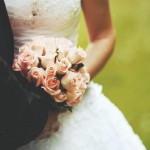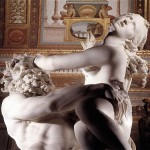Beautiful art is not just for cultural enrichment but is an important way to experience God and become aware of the human thirst for the infinite, Pope Benedict XVI has said.
A sculpture, a painting, a poem or a piece of music can arouse a feeling of joy when it becomes apparent it is something more than just a chunk of marble, a canvas covered with colours, or words or notes on a page, he said.
“It’s something bigger, something that speaks and touches your heart; it carries a message and lifts the spirit,” he said as he held his weekly general audience in the town square at Castel Gandolfo.
“Art is like an open doorway to the infinite, toward a beauty and truth that go beyond everyday reality,” he told 3,000 visitors and pilgrims present for the audience.
But the Holy Father’s remarks jibe even more profoundly (and I hope to explain why today or tomorrow) with Fr. Robert Barron’s soon-to-be-released book which — I’m telling you — is going to become an essential key in the opening of a glorious renewal of understanding and excitement within the church.
[the Cathedral of Cologne] speaks of the transcendence, strangeness and radical otherness of God. The building is telling us that whatever idea we have of God has to be abandoned as inadequate, the cathedral is summoning us always to look higher. But that same Cologne Cathedral, which speaks so compellingly of transcendence, preaches just as convincingly the immanence of God. All over the surface of the structure — but especially around the portals — one spies plants, animals, trees, planets, the sun and moon, angels, devils and saints — the whole panoply of creation, both natural and supernatural, vividly portrayed. All of these creatures have to do with God and God has to do with all of them. “The heavens proclaim the glory of God,” as do the things that crawl upon the earth, and as do the unseen spirits. God is sacramentally represented in all of the complexity of creation. The cathedral, in a word, is simultaneously telling us, in regard to God, “not here!” and “right here!” To grasp that tension is to have the most adequate understanding of the One Who Is.
— from Catholicism; A Journey to the Heart of the Faith
Those who suggest that too much art, too much beauty, is detrimental to worship might perhaps do well to sit quietly amid such beauty — putting aside prejudices or pre-conceived notions, to just sit with it — and see what they discover about God and contemplation and prayer.
Msgr. Charles Pope recently wrote about art, too, specifically the stained glass windows:
. . .stained glass also served another purpose, that of imaging the foundational walls of heaven. For, recall that traditional church architecture saw the church as an image of heaven. Hence it’s design was based on the descriptions of heaven found in the Scriptures. Now among other things, heaven is described in the Book of Revelation as having high walls with rows of jewels embedded in the foundations of those walls:
One of the seven angels…showed me the Holy City, Jerusalem, coming down out of heaven from God. It shone with the glory of God, and its brilliance was like that of a very precious jewel, like a jasper, clear as crystal. It had a great, high wall with twelve gates….The foundations of the city walls were decorated with every kind of precious stone. The first foundation was jasper, the second sapphire, the third chalcedony, the fourth emerald, the fifth sardonyx, the sixth carnelian, the seventh chrysolite, the eighth beryl, the ninth topaz, the tenth chrysoprase, the eleventh jacinth, and the twelfth amethyst…. (Revelation 21:varia)
Thus, because heaven had great high walls, older churches almost always had a lot of verticality. The lower foundational walls gave way to the higher clerestory, and above the clerestory the vaults of the ceiling rise even higher. And in the lower sections of the walls, extending even as high as the clerestory, the jewel-like stained glass recalls the precious jeweled gemstones described in the lower walls of heaven, according to Revelation 21.
The compelling effect of a traditional church is to say to the believer, you are in heaven now.
And all of that reminds me of something else Fr. Barron writes, early in Catholicism:
I stand with the theologian Hans Urs von Balthasar, who held that the truth of Catholicism is best appreciated from within the confines of the church, just as the windows of a cathedral, drab enough when seen from the outside, shine in all of their splendor when viewed from the inside. I want to take you deep into the cathedral of Catholicism, because I am convinced the experience will change and enhance your life.
And this, of course goes well with Barbara Nicolosi’s ruminations on art and friendship:
The Bible tells us that in the beginning God made things, and then He stood back and praised those things, as the first immutable art critic, saying, “It is good.” Then, at some point God made a new kind of being that could also make things and praise them. And then God stood back to see what we would do.
This is man’s uniqueness in the created cosmos. If you took us out, nothing would be missing except a recombining of the elements of creation to make new things, and also voices raised in awe and to say emphatically, “How good! So good!” So, if we as individuals are going to experience the satisfaction of filling out our destiny, we have to figure out fast what we are, a maker or a praiser, and then do it with sacrifice and intensity. Some people are both, but to be truly human, all of us need to be at some point in our lives either an artist or an artist’s friend. The order of the cosmos demands both.
Our church is rich in its beauties — spirit, liturgy, tradition, faith — and in its physicalities. Thankfully, she is also rich in beautiful minds such as these.
UPDATE: Speaking of art, Deacon Greg shows us the trailer for what looks to be a must-see of a film, and Max has bad haiku and bad statues, and Fr. Austin Fleming has a poem/prayer for the end of summer
We cannot help ourselves. Art is designed into us, Creator to creature.
Btw, that picture at the top was taken by my hubby last September, on our visit to Rome. Can’t believe it was a year ago, today, that we landed there!













